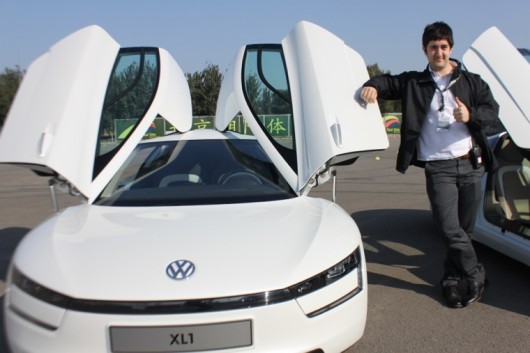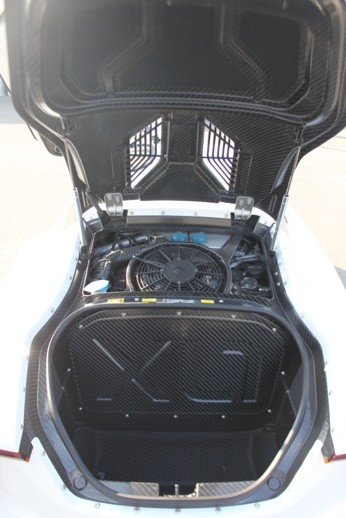
I test drove the Volkswagen XL1 on Friday at the Chaoyang Sports Center. What’s the XL1, you ask? Only the most efficient car in the world — efficient in every way, from weight to energy usage to fuel consumption (it can go 100 kilomters on one liter, thus the 1 in XL1). “Are there any areas in which you think you can do more optimization?” I asked Dr. Volker Kease, technical project manager.
“Nope,” he replied. “We’ve done what’s possible at the moment.”
He was neither boasting nor bluffing. The XL1 is fitted with Plexiglas windows, carbon seat frames instead of aluminum, a magnesium dual-clutch gearbox, and wood in select places inside the paneling, all in the name of optimization. Oh, and no side-view mirrors — those would be on the inside, via cameras — to reduce drag. It’s equipped with a lithium-ion battery and can roll 50 kilometers in electric mode alone, with zero emissions.
Despite all this, the car is still a car, as driveable as any. According to the specs, it can hit 100 km/h in 12.7 seconds. It handled exactly like a normal vehicle, though a minimalist one — and one that’s surely to draw eyeballs, if that’s the kind of thing you want.
Which is all to say that it could be the perfect car for China. Imagine a second-generation rich throwing down the big bucks for one of these attention-grabbers, simultaneously buying the right to gloat to friends that he’s saving the environment, too. I spoke to Lorenz Fuehrlinger of Audi China, who happens to be head of R&D, who agreed that China is primed for electric vehicles. “I’m convinced in the next 10 to 15 years we’re going to see this change,” he said. “Maybe in the next 15 years we’re going to see these systems in place.”
Therein lies the obstacle, of course: the systems, i.e. the infrastructure required — charging poles, for one — to support a network of electric vehicles. To say nothing of attitudes. But we entertainined the notion that attitudes will have to change. Fuehrlinger lives in Beijing, so he knows as well as you and I — and every official — about the P word. And from a policy standpoint, if you want to both stimulate car growth and curb emissions, wouldn’t e-vehicles be the obvious way to go? Consider: the proposed odd-even license plate restrictions are for days when there’s lots of pollution, not traffic. If that’s truly the worry, why not subsidize e-vehicles, or give them special licenses that exempt them from plate restrictions?
An e-vehicle maker’s dream, that. As one presenter said — disclosure: I was at a VW press event — e-vehicles “perfectly fit China and its market.” (Another executive told me pollution “frequently” comes up in VW’s discussions with Chinese officials.) You can expect to see more car companies move in on second- and third-tier cities with hybrid vehicles, since drivers there don’t necessarily have an entrenched preconception of how a car should operate — fuel tank is empty; fill fuel tank; drive until fuel tank is empty.
As for Volkswagen, they won’t be selling any XL1s in China, since only 250 of these vehicles will be made in the world. Fifty will be prototypes, and the rest will go on sale in Europe only. But as far as concept cars go, the concept is solid here. It’s one that people will eventually get behind. The only question for everyone else: how far ahead or behind the curve can you afford to get?
The man pictured above is Ali Khalili from the Volkswagen R&D Center in Beijing, who accompanied me on my test drive. He may have been slightly disappointed when I failed to hit the top speed of 160 km/h. Next time.




















































Looks like fun..
Your right i think about the need for e-vehicles in china, if they can’t work here, they cant work anywhere. Chinese drivers are much more city bound than american and European commuters and drive less reducing the impact of e-cars reduced range, also the key environmental need at the moment is to reduce particulate commissions within cities rather than pure Co2 considerations (where e-cars offer rather suspect benefits)
What seems strange is that the govt doesn’t role out a massive e-taxi scheme. China’s large taxi firms are all govt controlled and generally buy their vehicles on mass then lease them to the drivers. One would have thought this would implementing such a policy relatively simple. One could use a car such as the Nissan leaf where the battery can be switched out and create a series of ‘swap shops’ only for the taxis around the city.
If nothing else the Santanas here in Shanghai are very old in the tooth and could do with a change.
I imagine that much of the opposition to such policies comes from the various departments who would stand to take a hit to profitability.
this was a fairly interesting article on the diplomat
http://thediplomat.com/2013/10/23/how-the-chinese-bureaucracy-decides/
ah, progress. today, beijing’s traffic is a parking lot of polluting vehicles. in 2033 years, thanks to 2013 technology, it will be a parking lot of less polluting vehicles. living the american dream.
everything but improving and taking public transport, eh?
“in 2033,”
…………….. and as usual these vehicles types will be available to the public in ………. 2020 or 2021 ???!!